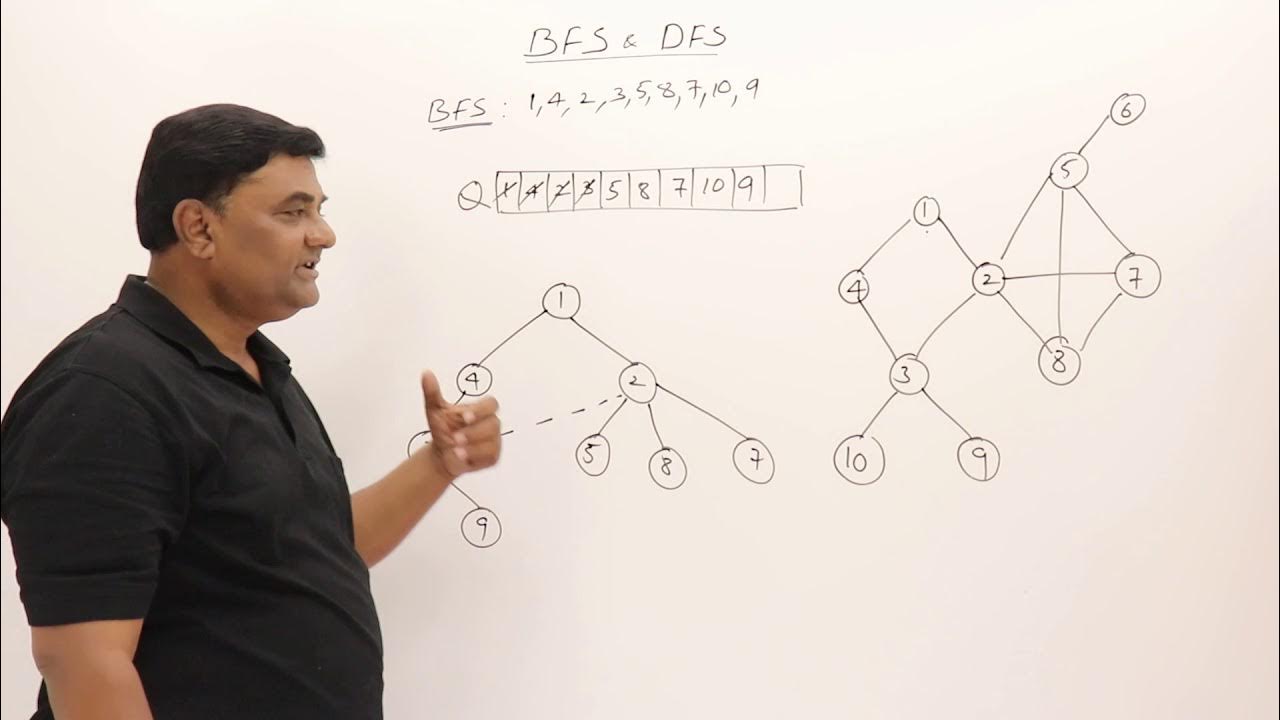AI - Ch03 - Uninformed search algorithms
Summary
TLDRThis video explains the fundamental concepts of search algorithms in AI, focusing on breadth-first search (BFS) and depth-first search (DFS). BFS expands the shallowest node first using a FIFO queue, ensuring the shortest path is found in an unweighted graph. In contrast, DFS explores the deepest node first with a stack, diving deep into one branch before backtracking. The video emphasizes the advantages of DFS in memory efficiency, as it only stores the current path and can discard fully explored nodes. These algorithms play a key role in AI, particularly in tree searches and constraint satisfaction problems.
Takeaways
- 😀 DFS always expands the deepest node in the search tree, exploring nodes as deeply as possible before backtracking.
- 😀 Unlike BFS, DFS uses a stack (LIFO structure) to determine which node to expand next, instead of a queue (FIFO structure).
- 😀 In DFS, when a node is fully explored, it is removed from the frontier, and the search backs up to the next deepest unexplored node.
- 😀 DFS is memory-efficient because it only stores the current path and the nodes that need to be expanded, unlike BFS which stores the entire tree or large sections of it.
- 😀 As DFS explores a tree, once a node’s descendants are fully explored, that node is discarded from memory, saving space.
- 😀 The fundamental difference between DFS and other algorithms like BFS is how nodes are chosen and removed from the frontier during search.
- 😀 DFS is especially useful in AI applications like constraint satisfaction problems, where you don’t need to track the entire search tree.
- 😀 DFS can be more efficient than BFS when searching in a tree without cycles, because it doesn’t have to remember all nodes.
- 😀 DFS works by expanding the deepest node in the current frontier first, often leading to a faster solution for deep paths.
- 😀 The DFS approach is ideal for problems where finding the solution path deeply is more important than exploring all options equally.
Q & A
What is the difference between BFS and DFS in terms of node expansion?
-BFS expands the shallowest node first, using a FIFO queue, whereas DFS always expands the deepest node first, using a LIFO stack.
Why is DFS more memory efficient compared to BFS in tree search?
-DFS only stores the current path and the nodes that need to be expanded next, while BFS stores all nodes at each level of the tree. This makes DFS less memory-intensive.
What data structure does BFS use to manage the frontier?
-BFS uses a FIFO (First In, First Out) queue to manage the frontier.
What data structure does DFS use for managing the frontier?
-DFS uses a LIFO (Last In, First Out) stack to manage the frontier.
How does DFS backtrack when exploring a tree?
-DFS backtracks by going to the most recent node that still has unexplored descendants. Once a node's descendants are fully explored, it is removed from memory.
In what way does DFS differ from BFS in terms of storing nodes during the search?
-DFS only stores a single path from the root node to a leaf node and the sibling nodes that need expansion, whereas BFS stores all nodes at each level of the search tree.
What happens when DFS reaches a node with no successors?
-When DFS reaches a node with no successors, it backtracks and explores other potential actions at previous nodes.
What are the main advantages of DFS over BFS in tree search?
-DFS is more memory efficient because it only needs to store the path currently being explored, and once a node's descendants are fully explored, they are removed from memory.
How can DFS be implemented in an algorithmic context?
-DFS can be implemented by replacing the frontier queue of BFS with a stack, and instead of selecting a leaf node from the frontier, the algorithm pops a node from the stack for expansion.
Why is DFS commonly used in AI applications?
-DFS is adopted in AI for tasks like constraint satisfaction problems because of its lower memory requirements compared to BFS, especially in deep trees or search spaces.
Outlines

هذا القسم متوفر فقط للمشتركين. يرجى الترقية للوصول إلى هذه الميزة.
قم بالترقية الآنMindmap

هذا القسم متوفر فقط للمشتركين. يرجى الترقية للوصول إلى هذه الميزة.
قم بالترقية الآنKeywords

هذا القسم متوفر فقط للمشتركين. يرجى الترقية للوصول إلى هذه الميزة.
قم بالترقية الآنHighlights

هذا القسم متوفر فقط للمشتركين. يرجى الترقية للوصول إلى هذه الميزة.
قم بالترقية الآنTranscripts

هذا القسم متوفر فقط للمشتركين. يرجى الترقية للوصول إلى هذه الميزة.
قم بالترقية الآنتصفح المزيد من مقاطع الفيديو ذات الصلة

Breadth First Search BFS

Projeto e Análise de Algoritmos - Aula 12 - Algoritmos de busca em largura e profundidade em grafos

Algoritma Greedy Best First Search dan A* (A star) + Contoh dan Penjelasan | Algoritma Struktur Data

5.1 Graph Traversals - BFS & DFS -Breadth First Search and Depth First Search

Depth First Search (DFS) Graph Traversal in Data Structures

The Best Order to learn Algorithms & Data Structures?
5.0 / 5 (0 votes)
